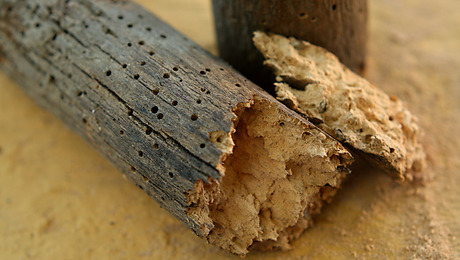Detailing for Wood Shrinkage
If you think ahead, you can avoid nail pops, cracked drywall and sloping floors.

Synopsis: A construction consultant explains the problems that can be caused by changes in the moisture content of dimensional and finished lumber. He includes tips for avoiding nail pops, bulges in floor framing, and miters that open and close with the season.
On a still night, people living in a new house often hear a loud creak or snap. They reassure themselves the house is just settling. But woodframe houses don’t really settle. They shrink.
A typical two-story, platform-framed house will shrink about 3/4 in. in height after it is built. Most of that shrinkage takes place in the first heating season as framing lumber gradually dries out. Builders are often called back to make minor repairs or adjustments that result from this first-year shrinkage.
Stairs might squeak. Nail heads pop through drywall. Doors no longer fit, or they show paint lines where panels have shrunk. Builders can disguise the movement, or build around it, but they can’t stop it. By accommodating wood movement, in the design and during construction, most problems can be avoided.
Wood and water
In a tree, wood is saturated with water. Some of it fills the cavities of wood’s hollow, strawlike cells; some of it swells the cell walls. To increase wood’s stiffness, strength, dimensional stability and usefulness, the water must be removed. When wood is dried—either in a kiln or outside in a stickered pile—water evaporates first from cell cavities. But even when all that water is gone, the lumber is the same size. Only when water starts to leave swollen cell walls do dimensions start to diminish.
Moisture content (MC) is the amount of water in wood, described as a percentage of the wood’s oven-dry weight. Minimum dimensions are reached when wood is oven-dry, or at 0% MC. For almost all kinds of unfinished wood, shrinkage begins when moisture content falls below about 30% (called the fiber-saturation point). Below this point, the amount of shrinkage is directly proportional to the moisture loss. (The converse is true when dry wood picks up water and swells.) Typically, the moisture content of wood in heated buildings ranges from about 4% to 16%, depending on the locale and the time of the year.
Because wood’s strawlike cells are in concentric circles (the growth rings), with their length parallel to the tree trunk, green lumber shrinks by different percentages in length, width and thickness during drying. With the exception of some kinds of abnormal wood, shortening along the grain (longitudinal shrinkage) is only about 0.1% from green to oven-dry. It usually can be ignored. But shrinkage across the grain, whether around the growth rings (tangential shrinkage) or across them (radial shrinkage), is substantial (drawing above). Across-the-grain shrinkage must be accounted for in the design of just about anything made from wood. Though shrinkage values vary widely among wood species, tangential shrinkage averages about 8%, and radial shrinkage about 4%.
Unequal shrinkage (and swelling) in the longitudinal, tangential and radial directions give rise to bowing, crooking, twisting, cupping and other forms of warpage commonly seen in lumber. Uneven shrinkage is also responsible for the wide checks and splits that open in large timbers used in post-and-beam construction.
To learn more about the potential for wood shrinkage, click the View PDF button below.
Fine Homebuilding Recommended Products
Fine Homebuilding receives a commission for items purchased through links on this site, including Amazon Associates and other affiliate advertising programs.

Code Check 10th Edition: An Illustrated Guide to Building a Safe House

The New Carbon Architecture: Building to Cool the Climate

A House Needs to Breathe...Or Does It?: An Introduction to Building Science


























